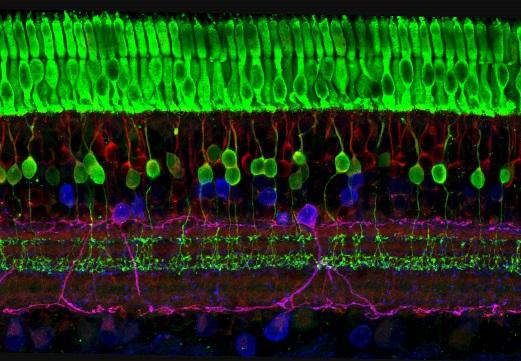The NEI Audacious Goals Initiative for Regenerative Medicine is catalyzing research that will enable the restoration of vision through regeneration of the retina—the light-sensitive tissue in the back of the eye. On its own, the body cannot replace cells of the retina. When retinal cells die, from disease or injury, they are gone for good. And with them goes the vision we too easily take for granted.
The NEI audacious goal is to restore vision through regeneration of neurons and neural connections in the eye and visual system. NEI is targeting the neurons in the retina and retinal ganglion cells, which transmit signals to the brain.
About the retina

The eye focuses light on the retina.
The retina is the light-sensitive tissue in the back of the eye. The eye focuses light on the retina. Across the retina are neurons called rod and cone photoreceptors. Light activates these neurons, which in turn activate a complex network of other retinal neurons. Together, these cells encode light into signals the brain can understand. Retinal ganglion cells, with their telephone wire-like axons, carry the signals through the optic nerve to the visual centers of the brain.
A powerful but delicate tissue

Ground squirrel retina magnified by confocal microscopy. Cone photoreceptors (green) can be seen in the top layer. Courtesy of Wei Li, NEI, NIH
For a tissue no larger than a postage stamp, the retina consumes lots of energy. Even when our bodies are at rest—for example, while watching a movie—our retinas are busy translating patterns of light into faces, landscapes, and action scenes. But vision quickly deteriorates when normal function of the retina is interrupted. There are hundreds of rare genetic disorders that affect the retina. Many common eye diseases affect the retina, too. For example, diabetic retinopathy damages blood vessels that support the retina. In age-related macular degeneration, the build-up of toxic materials deteriorates the tissue adjacent to the retina called the retinal pigment epithelium (RPE), which supports retinal function.
Glaucoma damages retinal ganglion cells, cutting off signals between the retina and the brain. All these conditions can lead to the death of retinal neurons. On its own, the body cannot regenerate retinal neurons.